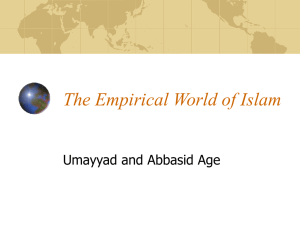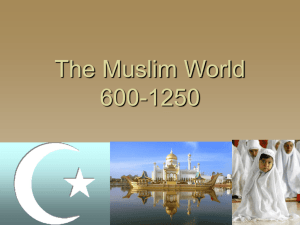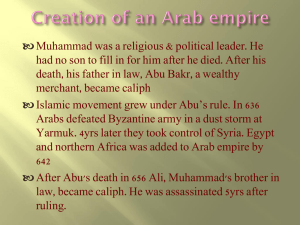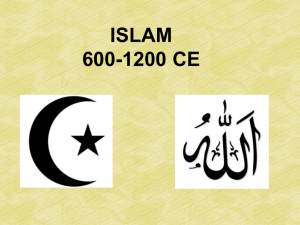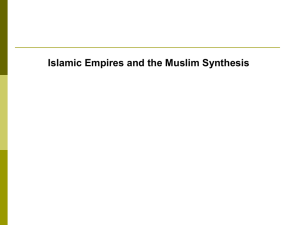Arab Empire Under the Abbasids
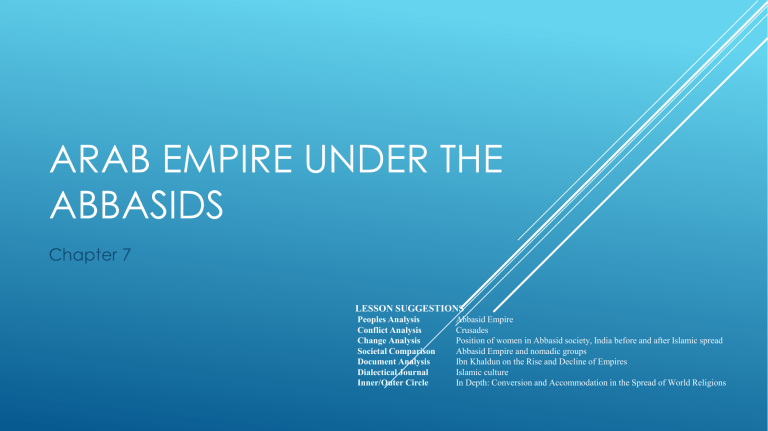
ARAB EMPIRE UNDER THE
ABBASIDS
Chapter 7
LESSON SUGGESTIONS
Peoples Analysis
Conflict Analysis
Change Analysis
Societal Comparison
Document Analysis
Dialectical Journal
Inner/Outer Circle
Abbasid Empire
Crusades
Position of women in Abbasid society, India before and after Islamic spread
Abbasid Empire and nomadic groups
Ibn Khaldun on the Rise and Decline of Empires
Islamic culture
In Depth: Conversion and Accommodation in the Spread of World Religions
Abbasid Dynasty (750-1258 BCE)
Referred to as the Golden Age of Islam
Broke down distinctions between Arab and non-
Arab Muslims
Moved caliphate capital to Baghdad (762 C.E)
Became commercial center for trade between
Europe, Asia, and Africa
Abbasid Dynasty (750-1258 BCE)
Government
Caliph became more of a king than a spiritual leader
Diwan – council for advising caliph (did not speak directly with leader)
Vizier – Prime Minister of the diwan
Abbasid Dynasty (750-1258 BCE)
Important rulers (Caliphs)
Abu al- Abbas – founder of the Abbasid
Harun al-Rashid (r.786-809 C.E.) – moved dynasty in “Golden Age”
Al-Ma’mun (r.813-833 C.E.) – built astronomy observatory in Baghdad and established foundation to translate classical Greek works
Golden Age of Islam
Society
Considered the most egalitarian of its time
Ideal citizens – judges, merchants, and gov’t officials v. warriors
Slavery was widespread – could not be
Muslim. Most slaves served in the army
Golden Age of Islam
Culture
Arabs considered the heirs to remaining
Greco-Roman culture
Greek, Syrian, and Persian scientific and philosophical works were translated into
Arabic and eventually found their way back to Europe
Arabic became an international language
Contributions under the Golden Age of Islam
Philosophy
Preserved achievements of classical civilizations
Ibn Rushd spread classical ideas from Spain back into Europe
Contributions under the Golden Age of Islam
Science
Accurately recalculate circumference of the Earth
Studies eclipses
Contributions under the Golden Age of Islam
Medicine
Required doctors to pass difficult tests before practicing
Set up hospitals with emergency rooms
Contributions under the Golden Age of Islam
Medicine
Ibn Sima (980-1037 C.E.)
Compiled a medical encyclopedia that emphasized the contagious nature of disease
Showed how disease could be spread through contaminated water
Work became basis for medical textbooks used by medieval European universities
Contributions under the Golden Age of Islam
Mathematics
Improved upon works developed by Indian civilization under the Gupta
Al-jabr – Persian mathematician whose work provided the basis for modern algebra
Contributions under the Golden Age of Islam
Literature
Qu’ran – regarded as greatest literary work
Omar Khayyam
Works popular in the west
Wrote Rubaiyat and Tales from 1001
Nights (The Arabian Nights)
Contributions under the Golden Age of Islam
Literature
Sadi (1210-1292 C.E)
Considered the Persian Shakespeare
Wrote Rose Garden
Rabe’a of Qozdar
First female poet
Wrote about suffering that love can bring
Contributions under the Golden Age of Islam
Literature
Al-Mas’udi
First great Muslim historian
Wrote Meadows of Gold which provides for our knowledge of the Abbasid
Dynasty
Contributions under the Golden Age of Islam
Education
Established universities and libraries in Cairo,
Baghdad, Cordoba, and Timbuktu
Emphasis on preserving, translating, and advancing Greco-Roman, Egyptian, and
Indian knowledge
Contributions under the Golden Age of Islam
Art and Architecture
Blend of Arab, Turkish, and Persian traditions
Used Byzantine knowledge to design domes and arches
Calligraphy
Beautiful writing and patterns to decorate building and art
Forbidden to depict Muhammad and
Allah’s creation
Contributions under the Golden Age of Islam
Art and Architecture
Dome of the Rock (691 C.E.)
Touches both the Western Wall of the
Jews and oldest Christian church
Great Mosque of Samarra (848-852 C.E.)
Largest mosque ever constructed
Covers 10 acres of land and contained 464 pillars
Contributions under the Golden Age of Islam
Art and Architecture
Mosque at Cordoba
Located in southern Spain
Contains 514 columns in work
Decline of the Abbasid Dynasty
Internal problems
Lack of spiritual authority weakened caliphate in competition with rivals
Ex. Umayyad Dynasty in Spain
Ex. Fatimid Dynasty (Shi’ite in Egypt
(973 C.E.)
Decline of the Abbasid Dynasty
Internal problems
Wealth led to corruption
Caliphs awarded positions to favorites
Luxurious life enjoyed by caliph undermined strict moral code
Changes within army and bureaucracy
Shortage of Arabs for qualified positions
Decline of the Abbasid Dynasty
Seljuk Turks
Nomadic Group from Central Asia
Converted to Islam and flourished as mercenaries for the Abbasids
Moved into Iran and Armenia as Abbasid power weakened
Decline of the Abbasid Dynasty
Seljuk Turks
Took over Baghdad (1055 C.E.)
Leader appointed himself as sultan
(“holder of power”)
Abbasid leaders maintained religious power in area
Exerted military pressure on Egypt and Byzantine
Defeat of Byzantine at Manzikert (1071 C.E) helped trigger rally for Crusades
Decline of the Abbasid Dynasty
The Mongols
Pastoral people who emerged from the Gobi desert in the 1200s C.E.
Seized control over much of the known world
Originally led by Genghis Khan
Helegu
Brother of Kublai Khan
Seized Persia, Mesopotamia, and conquered Abbasid
Brutally wiped out those conquered and their lands
Eventually converted to Islam and blended with culture of area conquered
The Crusades – (Middle Eastern Perspective)
Crusades (1096 – 1300s C.E.)
Series of wars fought between Christians and Muslims over control of the holy land of Jerusalem
Resulted from calls for help by Byzantine ruler
Alexius I to Western Europe, after defeats from
Seljuk Turks
Claimed Muslims were desecrating Christian shrines
The Crusades – (Middle Eastern Perspective)
Crusades (1096 – 1300s C.E.)
Islamic world originally taken aback by crusaders
Saladin (Salah al-Din)
Claimed title of sultan for the lands of the former
Fatamid caliphate
Invaded kingdom of Jerusalem and destroyed
Christian forces concentrated there (1187 C.E.)
Showed tolerance to conquered Christians
The Crusades – (Middle Eastern Perspective)
Crusades (1096 – 1300s C.E.)
Results
Displayed superiority of Muslim technology
Displayed impact of Muslim culture on the Middle
East
Renewed trade and cultural contacts with
Europeans
Created a united Muslim group against Christians, created mistrust that survives today
